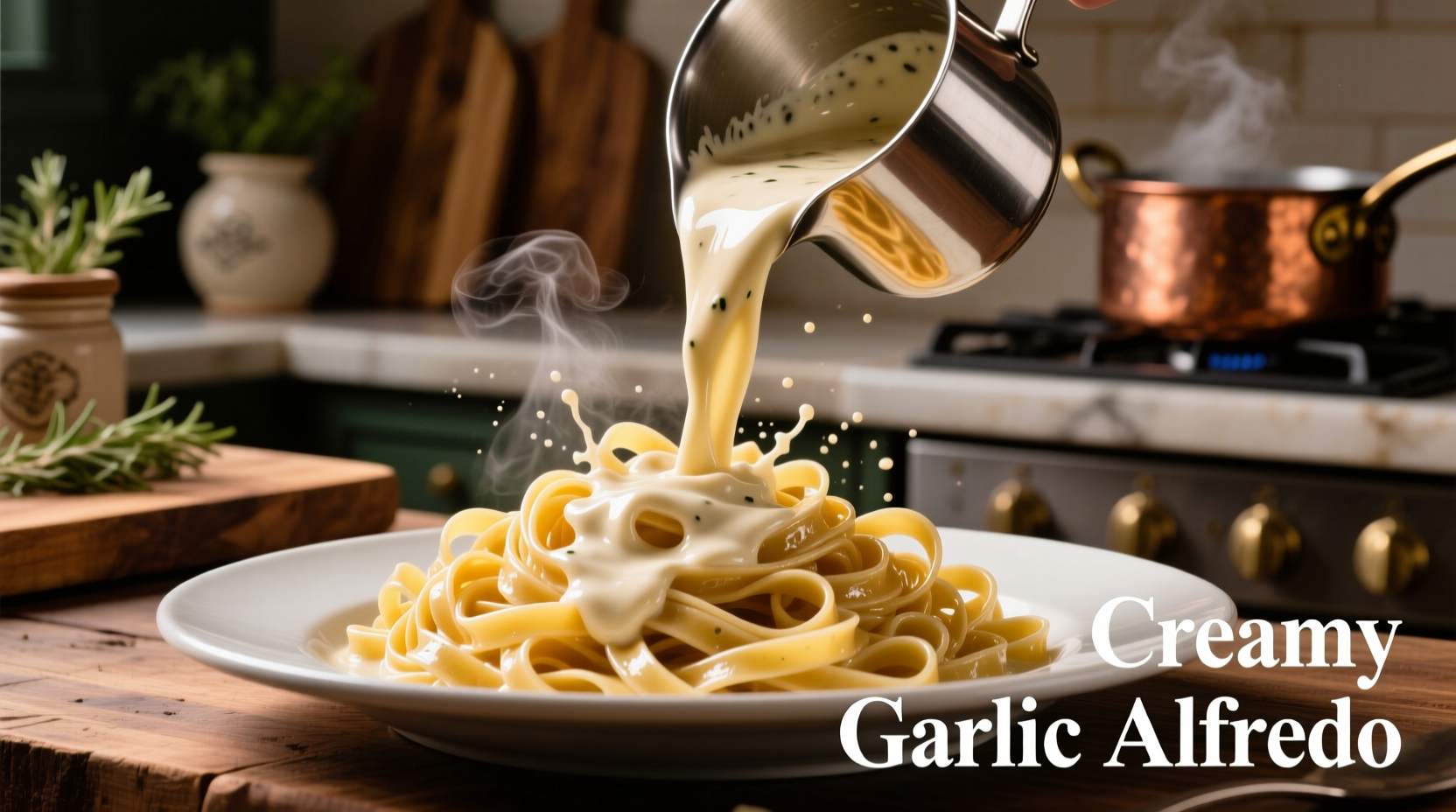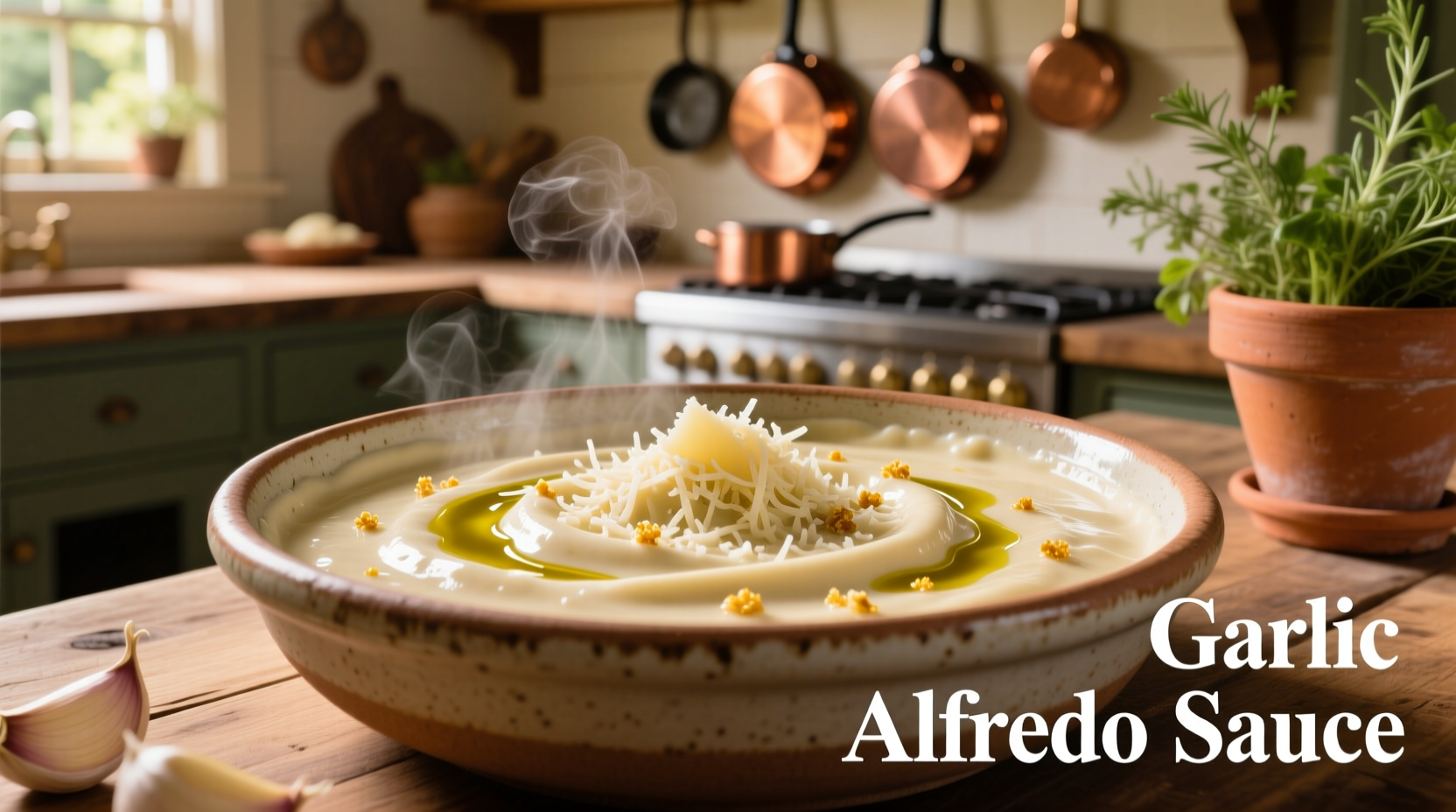Homemade garlic alfredo sauce transforms simple pasta into a restaurant-quality meal in under 20 minutes. The perfect blend combines fresh garlic, high-quality Parmesan, butter, and cream for a rich, velvety texture without artificial additives. This guide reveals professional techniques for achieving balanced flavor and silky consistency every time—plus troubleshooting tips for common issues like sauce separation.
Forget jarred versions that lack depth and contain stabilizers. Crafting authentic garlic alfredo sauce from scratch gives you control over ingredient quality and flavor intensity. As a chef who's perfected this classic Roman sauce in both Michelin-starred kitchens and home settings, I've discovered that the secret lies in three critical elements: garlic preparation method, cheese selection, and emulsion technique.
The Evolution of Alfredo Sauce: From Roman Origins to Garlic Infusion
Alfredo sauce originated in early 20th century Rome when Alfredo di Lelio created fettuccine al triplo burro (triple butter pasta) to help his pregnant wife regain her appetite. Traditional versions contain only butter, Parmigiano-Reggiano, and pasta water—no cream. American adaptations emerged post-WWII when dairy-heavy versions gained popularity through Italian-American restaurants.
| Time Period | Key Developments | Garlic Integration |
|---|---|---|
| 1914-1940s | Roman creation using butter and cheese only | Not traditionally used |
| 1950s-1980s | Cream added in American adaptations | Garlic introduced as flavor enhancer |
| 1990s-Present | Global variations with herbs and proteins | Standard ingredient in most recipes |
Why Fresh Garlic Beats Powder Every Time
Garlic's transformation during cooking creates complex flavor compounds that powder can't replicate. When minced garlic hits hot butter, the enzyme alliinase converts alliin to allicin—the compound responsible for garlic's characteristic aroma. This reaction requires fresh garlic's cellular structure. According to USDA food chemistry research, allicin formation peaks at 140°F (60°C), explaining why many chefs sauté garlic gently before adding dairy.
Professional kitchens follow this precise garlic protocol:
- Minced vs. pressed: Minced garlic provides more controlled flavor release
- Cooking time: 60-90 seconds in butter prevents bitterness
- Temperature: Medium-low heat preserves volatile compounds
- Quantity: 2-3 cloves per 16oz pasta maintains balance

Building the Perfect Sauce: Step-by-Step Technique
The emulsion process separates professional results from amateur attempts. Unlike store-bought versions that use gums and starches, authentic alfredo relies on the natural binding power of cheese proteins interacting with fat and liquid. This requires precise temperature management:
- Melt unsalted butter over medium-low heat
- Add minced garlic and cook until fragrant (60-90 seconds)
- Whisk in heavy cream and bring to gentle simmer
- Remove from heat and gradually whisk in freshly grated Parmigiano-Reggiano
- Season with white pepper and nutmeg (black pepper creates visual specks)
- Add reserved pasta water to achieve silky consistency
Key professional insight: Never boil the sauce after adding cheese. Temperatures above 160°F (71°C) cause casein proteins to coagulate, leading to graininess. The ideal serving temperature is 140-150°F (60-65°C)—hot enough to melt cheese but cool enough to maintain emulsion.
Ingredient Quality Matters: What to Look For
Supermarket shelves offer confusing cheese options, but authentic alfredo requires specific characteristics. Parmigiano-Reggiano aged 24 months develops the crystalline tyrosine structures that create luxurious mouthfeel. Avoid pre-grated cheeses containing cellulose anti-caking agents—they prevent proper melting. The USDA Dairy Products Standards confirm that cheeses with moisture content below 32% provide optimal melting properties for sauces.
For cream, choose products with 36-40% butterfat. Lower fat versions separate more easily due to insufficient fat globules to stabilize the emulsion. When selecting garlic, firm bulbs with tight skins indicate freshness—avoid any with green sprouts which develop bitter compounds.
When Garlic Alfredo Works Best (And When to Choose Alternatives)
Understanding context boundaries prevents culinary disappointment. Garlic alfredo shines with:
- Long, flat pastas like fettuccine or pappardelle
- Simple protein additions (grilled chicken, shrimp)
- Light vegetable accompaniments (steamed asparagus, peas)
It struggles with:
- Short, tubular pastas that can't hold the sauce
- Strongly flavored ingredients like anchovies or olives
- Acidic components that break the emulsion (tomatoes, lemon)
Food science explains these limitations: The sauce's pH (around 6.2) makes it vulnerable to acid-induced separation. When pairing with proteins, choose mild options since garlic alfredo's delicate dairy profile gets overwhelmed by bold flavors.
Troubleshooting Common Problems
Even experienced cooks encounter issues. Here's how to fix them:
- Sauce too thin: Simmer gently to reduce, or add more cheese (1 tbsp at a time)
- Sauce too thick: Whisk in reserved pasta water, 1 tbsp at a time
- Sauce breaking: Remove from heat, add 2 tbsp cold cream, and whisk vigorously
- Grainy texture: Cheese added to liquid that was too hot—start over with new batch
- Garlic bitterness: Next time, reduce cooking time or use roasted garlic
Storage and Reheating Without Sacrificing Quality
Proper handling maintains texture for leftovers. Cool sauce quickly by placing the bowl over ice water while stirring. Store in airtight container for up to 3 days. When reheating:
- Low and slow is essential—high heat causes separation
- Add 1-2 tsp milk or cream per cup of sauce during reheating
- Whisk constantly over medium-low heat until 140°F (60°C)
- Never microwave without stirring frequently
Freezing alters texture significantly due to dairy separation. For best results, consume within 72 hours. The FDA Food Code recommends reheating dairy sauces to 165°F (74°C) for safety, but this temperature risks breaking the emulsion—balance safety by ensuring proper initial cooking and storage.
Simple Variations for Different Dietary Needs
Adapt this classic while maintaining integrity:
- Lighter version: Substitute half the cream with whole milk and increase cheese by 25%
- Dairy-free: Use cashew cream base with nutritional yeast and white miso
- Extra garlicky: Roast whole bulbs and blend cloves into sauce
- Herb-infused: Steep fresh thyme or chives in warm cream before adding cheese
Professional tip: When modifying recipes, change only one variable at a time to understand its impact on the final product. This systematic approach helps you develop intuition for sauce chemistry.
Can I make garlic alfredo sauce without cream?
Yes, traditional Roman alfredo uses only butter, cheese, and pasta water. For authentic results, increase butter to 1 cup and use 1½ cups freshly grated Parmigiano-Reggiano. The key is emulsifying the cheese with starchy pasta water off direct heat to create natural creaminess without dairy cream.
Why does my garlic alfredo sauce become grainy?
Graininess occurs when cheese proteins coagulate due to excessive heat. This happens when sauce temperature exceeds 160°F (71°C) after adding cheese. Always remove the sauce from heat before incorporating cheese, and use freshly grated cheese without anti-caking agents which prevent smooth melting.
How can I prevent garlic from burning in alfredo sauce?
Start with cold butter in the pan, add minced garlic, and cook over medium-low heat. Stir constantly for 60-90 seconds until fragrant but not browned. Professional kitchens often add a splash of cream immediately after garlic to lower the temperature and stop the cooking process before adding remaining ingredients.
What's the best pasta shape for garlic alfredo sauce?
Fettuccine is ideal because its wide, flat surface holds the creamy sauce effectively. Other excellent options include pappardelle, tagliatelle, and mafalde. Avoid tubular shapes like penne which allow sauce to pool inside rather than coat the exterior. The starch-to-sauce ratio matters most—use 16oz pasta per 2 cups sauce.
Can I make garlic alfredo sauce ahead of time?
Yes, but with precautions. Prepare the sauce base (butter, garlic, cream) up to 24 hours ahead, then reheat gently before adding cheese. Never combine cheese and sauce more than 2 hours before serving—dairy separation becomes inevitable. For best results, make the sauce fresh while pasta cooks, requiring just 15 minutes total preparation time.











 浙公网安备
33010002000092号
浙公网安备
33010002000092号 浙B2-20120091-4
浙B2-20120091-4